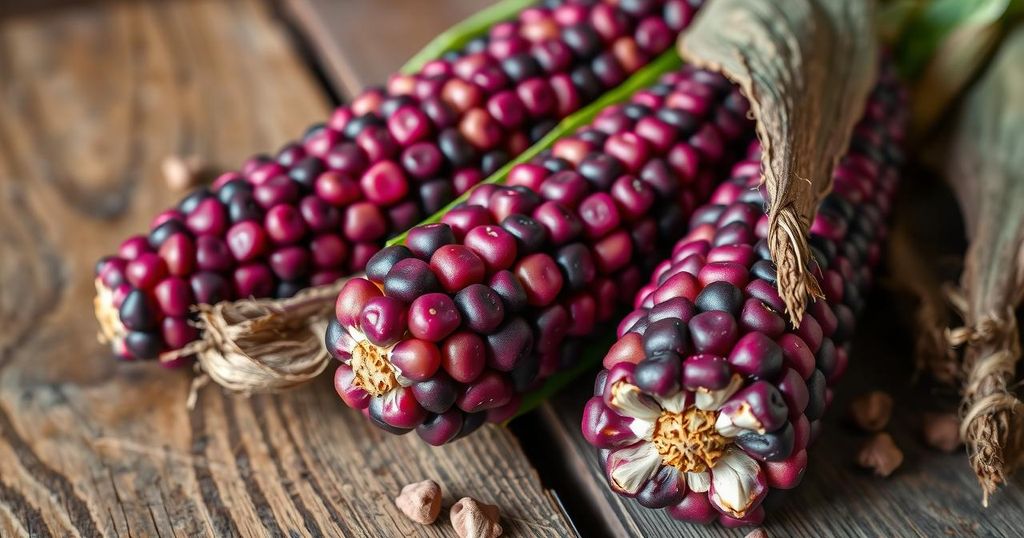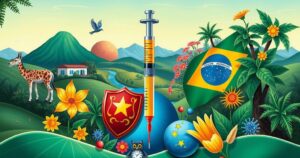Peruvian Purple Corn: A Superfood with Rich Benefits and Cultural Heritage

Peruvian purple corn is being celebrated for its health benefits and agricultural significance, especially in Cajamarca, where it has been cultivated for centuries. Recent research highlights its potential to prevent diseases like cancer and diabetes, with the development of the INIA 601 variety showcasing modern advancements in nutrition. The Peruvian government has also designated Cajamarca as the national capital of purple corn to foster agricultural growth.
Purple corn, a notable staple of Peru, recently took center stage during the National Day of Purple Corn celebrations on May 5. This event offered an ideal moment to shine light on its significance, especially in relation to the Cajamarca region. Cultivated since pre-Hispanic times, purple corn, scientifically known as Zea mays, thrives in specific conditions that are typical to its native land, making it a unique agricultural product.
What sets Peruvian purple corn apart is its remarkable capacity to adapt to acidic soils and high sunlight exposure, traits not commonly found in other regions. This ancient crop has garnered significant interest among scientists due to its exceptional nutritional benefits. Purple corn is loaded with anthocyanins, which are antioxidants that not only provide its vibrant color but also play an essential role in neutralizing harmful free radicals associated with various diseases.
Research indicates that the antioxidants present in both the kernels and cobs might help in preventing several ailments, including colon cancer and cardiovascular diseases. Aside from its antioxidant content, purple corn also supplies minerals like iron and calcium—helping combat anemia and supporting strong bones—while aiding blood circulation and overall heart health.
A noteworthy point is its potential in managing conditions such as obesity and diabetes due to its high fiber content, which enhances digestion and promotes feelings of fullness. In 2019, researchers at the National Institute of Agricultural Innovation (INIA) introduced a nutrient-dense variety named INIA 601. This strain not only yields over five tons per hectare but is also enriched with higher levels of anthocyanins, making it particularly valuable.
Led by agronomist Alicia Medina Hoyos, the research assessed various strains across 14 farms, confirming that INIA 601 excelled in terms of productivity and its overall health benefits. Moreover, a collaborative effort between the National Autonomous University of Chota, INIA, and the National University of Jaén is underway to further enhance the bioactive properties of this purple corn variety through innovative techniques.
Researchers have identified additional compounds, such as procyanidin B2 and resveratrol, which are known for their health benefits, including anti-aging and cholesterol-lowering effects. Lead researcher Tony Steven Chuquizuta noted that these findings could not only enrich culinary applications but might also pave the way for pharmaceutical uses, elevating the market potential for local farmers.
In a significant development, the Peruvian government declared Cajamarca as the national capital of purple corn on April 4, through Law 32287. This designation highlights the importance of the INIA 601 variety and aims to bolster purple corn production and agricultural exports, creating a focus on family farming and enhancing the competitivity of Peru’s agricultural sector.
The law, previously recognised by Congress, encompasses family farmers as well as agricultural producers engaged in growing and harvesting purple corn. Subsequently, the III Festival of Knowledge and Entrepreneurship showcased INIA 601 among other varieties of corn, underscoring the cultural richness and economic potential tied to these crops. The event celebrated the recognition of these corn varieties as part of Peru’s Natural Heritage, given their historical significance.
Overall, purple corn stands as a remarkable example of how traditional crops can provide substantial health benefits and economic opportunities, aligning with modern agricultural advancements and public health initiatives.
In summary, the Peruvian purple corn has emerged as a vital superfood, exhibiting numerous health benefits tied to its rich antioxidant content and various essential nutrients. Celebrated for its historical significance and recent scientific advancements, particularly with the INIA 601 variety, purple corn continues to symbolize both cultural heritage and agricultural innovation in Peru. As Cajamarca’s recognition as the national capital of purple corn unfolds, efforts to boost production and awareness may pave the way for brighter futures, both in health and economic terms.
Original Source: andina.pe








